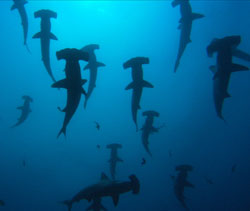ESR Specials are integrated multiauthor syntheses initiated and coordinated by acknowledged experts. They highlight cutting-edge research areas or problems and/or bring together cogent bodies of literature on key taxa. Typically they are led by one or more members of the ESR Editorial Board, sometimes including Guest Editors. We welcome additional suggestions for Specials; contact ESR Editor in Chief, Prof. Brendan Godley.

Photo: Sierra Ison

Photo: Arnaud Brival

ProDelphinus

Photo: Hyago Luiz

Photo: L. Chilvers

© Duke Marine Robotics and Remote Sensing Lab, NOAA Permit No. 14809-03

Adult female smalltooth sawfish Pristis pectinata tagged with an archival satellite tag off the Florida Keys.
Photo credit: Dean Grubbs


Photos by Mark Dodd (left) and Blair Witherington (right)

Photo: Yuri Yakovlev

Oceanographic remote sensing and biological diversity estimates can be combined in Geographic Information Systems to model the pelagic environment.
Image: Marine Geospatial Ecology Lab, Duke University

From left to right: Sumatran slow loris Nycticebus coucang hilleri, pygmy slow loris N. pygmaeus; Javan slow loris N. javanicus; Bengal slow loris N. bengalensis
Photo (from left to right): K.A.I. Nekaris, K.A.I. Nekaris, A. Walmsley, N. Das

Humpback and right whale high-use areas in the Gulf of Maine shown on a regional sea surface temperature image.
La Plata dolphin Pontoporia blainvillei entangled in a standard gillnet.
Photo: P. Bordino

Colorado River in the Grand Canyon
Photo: Craig Paukert.

Courtesy of Christoph Schwitzer

Photo: Dwi, WCU Sumatra

Photo: Daniel Costa

Forensic methods have been used to trace the origin of marketed shark fins. Scalloped hammerhead sharks Sphyma lewini are particularly vulnerable to capture for the fin trade because of their predictable schooling behaviour, especially at seamounts. This photograph was taken at Cocos Island in the eastern Pacific.
Photo: Save Our Seas Foundation

Sulawesi dawn bat Eonycteris spelaea rosenbergii captured in a mist net.
Photo: S. Rossiter

Goliath grouper Epinephelus itajara nestled in the wreck of a shrimping boat, off Key West, Florida
Photo: ©Doug Perrine/SeaPics.com

Biodiversity in our hands.
Illustration: Penny Kuhn

Longhorn beetles Leptura maculata are individually marked with ink to study the population size and structure of the species. Population size is one of the key criteria for completing an IUCN Red List assessment, but baseline data are lacking for saproxylic insects (see Komonen et al. this Theme Section).
Photo: A. Komonen

Graveyard of bycaught loggerhead turtle carcasses washed ashore at Playa San Lazaro, Baja California
Photo: Terry Garland

A gentoo penguin Pygoscelis papua in Antarctica equipped with a prototype ‘Daily Diary’ in 1992. This system, now hugely enhanced, provides details on travel routes, behaviour, energy expenditure and the environmental conditions encountered by free-living animals (see Wilson et al. this Theme Section)
Photo: Rory Wilson
There are currently no Specials in progress. Please see the ‘Complete' tab for a list of published Specials. If you are interested in proposing a Special please contact the Editor-in-Chief or Managing Editor with a summary of the topic, proposed submission date and a list of expected contributions (authors, titles) if available.